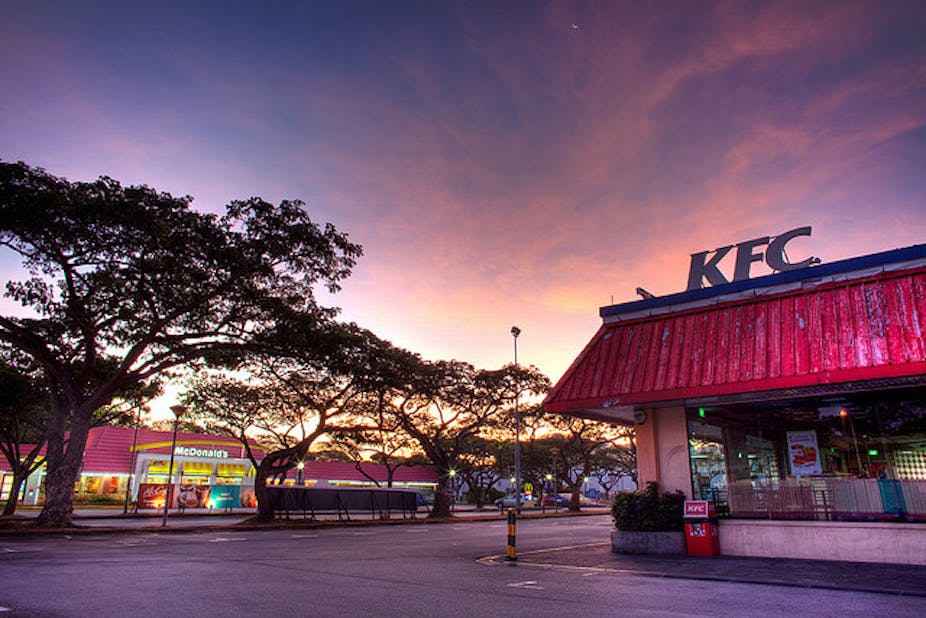Refugees settling in Australia constantly face new challenges. They have to re-adjust to new income levels, cultural practices and language. They also face a new food environment, where many traditional foods aren’t available and Western foods and preparation styles seem strange or unfamiliar.
In Australia, refugees are often resettled in areas with many unhealthy foods outlets and poor access to fresh fruit and vegetables. Newly arrived refugees have little money to spend on food. They also often don’t have access to a car or nearby public transport, diminishing their ability to make healthy food choices.
This situation is leading to an unhealthy assimilation. By adopting unhealthy diets, refugees are at risk of excess weight gain. In turn, that can lead to chronic illnesses such as type 2 diabetes, cardiovascular disease, arthritis and osteoporosis.
Existing disadvantage
For refugees, many factors impact on food preferences. These include housing insecurity, employment, financial hardship, changed social status and adapting to a new culture and environment. Parents may prioritise other settlement needs, such as settling children into school and earning an income, ahead of their own health.
Added to these burdens, many newly arrived refugees are contending with significant mental health issues. A large British review that tracked 7,000 refugees in resettlement found 9% of adults and 11% of children had post-traumatic stress disorder (PTSD) and 5% of adults suffered major depression.
Pre-arrival factors that may continue to influence diet and nutrition during settlement include prolonged deprivation, malnutrition, contaminated water, untreated or undiagnosed illnesses such as parasitic infections and chronic diarrhoea, and dental problems that may cause difficulties eating.
Refugees are then faced with unfamiliar Western foods, different food preparation styles, changes to lifestyle and exercise, lack of nutritional education and reduced local access to affordable food. They may not be able to access the traditional foods they’re used to and prefer.
The poor financial situation refugees find themselves in, coupled with a lack of family support and multiple psychosocial stressors, greatly diminishes their ability to make healthy food choices.
Case study: Woodridge
We mapped the availability of food outlets and vegetable consumption among a group of resettled African refugees in Woodridge, in Queensland’s Logan Central area.
Woodridge has a total population of 20,650. There are 0.9 fast food outlets per 1,000 people and only 0.1 healthy food outlets per 1,000 people.
We asked 28 participants to complete a questionnaire on household vegetable availability and consumption. The participants ranged in age from 19 to 52 and had lived in Australia for an average of 4.5 years.
We then mapped the routes (using the streets network analysis) from each of the 28 participants’ households to their nearest food outlet.
Within a radius of two kilometres from their home, the participants had access to three healthy food outlets, with a median distance of 841 metres and walking time of 10.5 minutes. They had access to 19 fast food outlets, with a median distance of 641 metres and walking time of eight minutes.
We found participants who lived near a healthy food outlet such as a supermarket or farmers’ market had a higher intake of vegetables than those who lived further away. The critical threshold was around 400 metres.
Those who had significantly better access to takeaways and convenience food shops favoured unhealthy food.
Adapting to the new food environment
This complex problem requires a strategic multilevel response. Public health policymakers need to work with refugee communities to develop and implement health promotion strategies to improve diet and nutrition early in the settlement process.
First, initial health assessments must identify nutritional deficiencies and take into consideration the impacts of malnutrition.
Second, newly arrived communities need more information and education about the nutritional value of Western foods, how to assess their healthiness and how to substitute unhealthy foods with more nutritious options. Dietitians and social workers also need to be trained to address cultural differences and traditional preferences.
A culturally sensitive model to “train the trainers” could help newly arrived refugees adapt to their new food environment. This is when one individual from the community is trained, then teaches the skills to others and so on. The training could increase awareness of available healthy Western food, improve cooking skills and educate community members about the impact of unhealthy diets on health.
Finally, and most importantly, governments need to act on the heavy distribution of unhealthy food outlets and lack of access to healthy foods, particularly in refugee settlement areas.
This article was co-authored by former Griffith University PhD student Catherine Gichunge.

